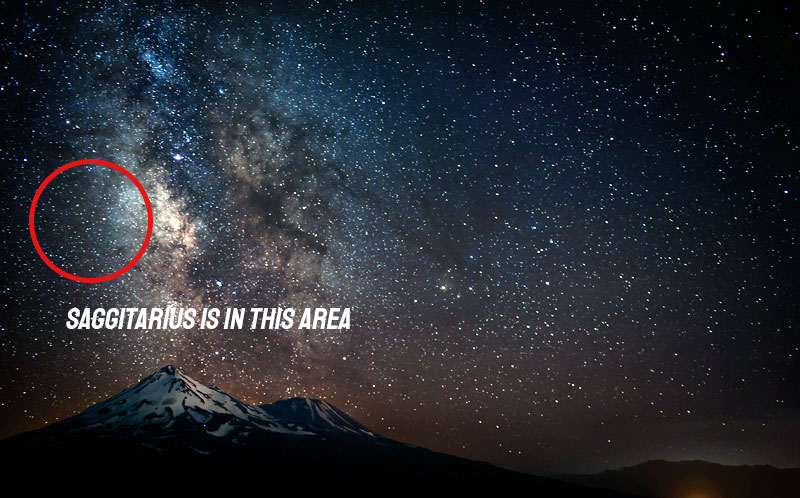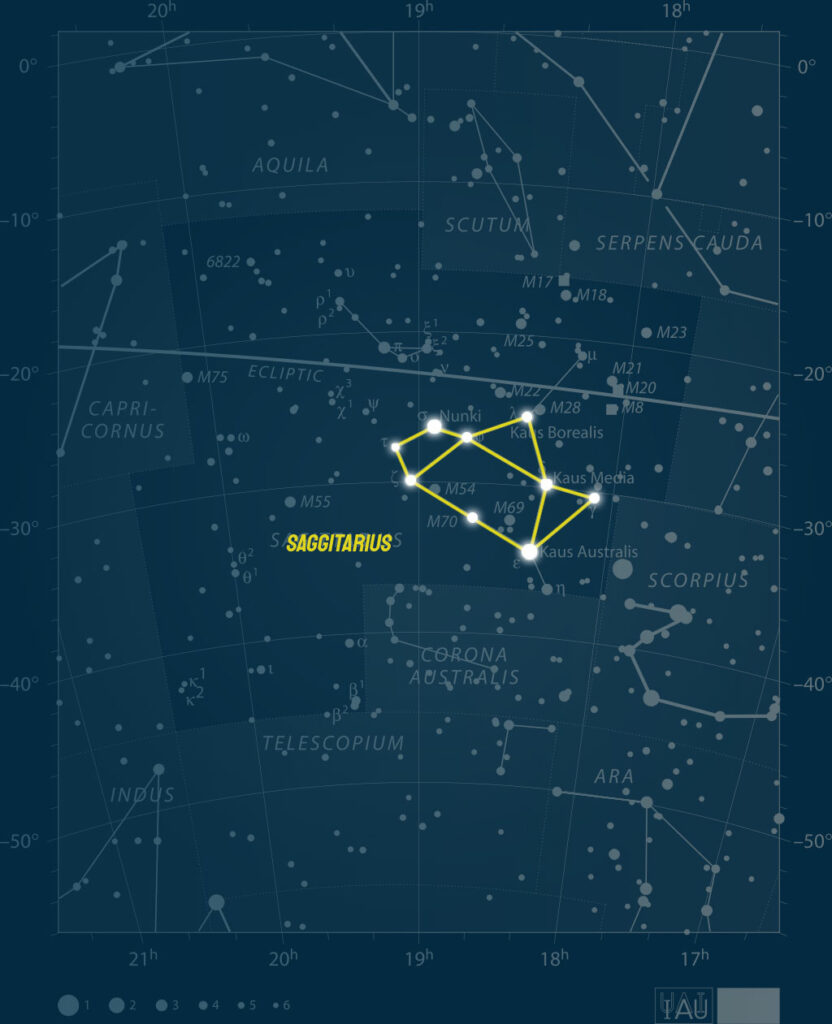Locating constellations in the sky is a fun, and easy way to learn more about astronomy.
The Saggitarius constellation, also known as the archer, is one of the 88 recognized constellations in the sky and is also part of the twelve zodiac constellations.
Finding Saggitarius in the night sky is not as easy as finding other more prominent constellations due to its location and the relatively low brightness of its stars, but there are multiple methods to achieve it, which makes things simpler.
But first, here is some general information about Saggitarius
| Name | Saggitarius |
| Abbreviation | Sgr |
| Genitive | Sagittarii |
| Meaning | The archer |
| Main stars | 12 |
| Bayer stars | 68 |
| Discovered stars with planets | 32 |
| Brightest star | Kaus Australis (Epsilon Sagittarii) |
| Location | Quadrant SQ4 |
| Visible latitudes | +55 to -90 |
| Meteor showers | The Sagittariids (Jun 1st – Jul 15th) |
| Neighboring constellations | Scorpius, Aquila, Scutum, Ophiucus, Capricornus |
When and where is the Saggitarius constellation visible
Saggitarius is visible in the sky between February and November. The best time to observe it is in August when it can be found directly overhead at around 21:00 of your local time.
Between December and January, the constellation is positioned behind the Sun, making it impossible to view from Earth.
Saggitarius is found in the southern square SQ4 in the sky, and can be seen between the latitudes of +55 to -90, as a reference, this means it can be viewed from anywhere south of Vancouver, London, or Berlin. Saggitarius cannot be seen in places like Alaska, Sweden, or St. Petersburg.
The following table will tell you the times at which this constellation can be seen for each month.
| Month | Visible | Not visible |
|---|---|---|
| January | not visible | not visible |
| February | 4:30 AM to sunrise | sunset to 4:30 AM |
| March | 2:30 AM to sunrise | sunset to 2:30 AM |
| April | 2:00 AM to sunrise | sunset to 2:00 AM |
| May | 00:30 AM to sunrise | sunset to 00:30 AM |
| June | 10:30 PM to sunrise | sunset to 10:30 PM |
| July | 8:30 PM to 3:30 AM | sunset to 8:30 PM/3:30 AM to sunrise |
| August | sunset to 1:30 AM | 1:30 AM to sunrise |
| September | sunset to 11:30 PM | 11:30 PM to sunrise |
| October | sunset to 8:30 PM | 8:30 PM to sunrise |
| November | sunset to 7:30 PM | 7:30 PM to sunrise |
| December | not visible | not visible |
Just like the Sun and the Moon, constellations also rise in the East and set in the West, so if the rise time listed in the table above is after sunset, it means you will see Saggitarius rising to the East at that time. However, from August to November, it will already be up in the sky by the time the Sun sets.
Saggitarius can be seen without a telescope from places with mid to low light pollution. If you are in a big city, you might need the help of a telescope to fully appreciate it.
Weather also plays an important factor in how easy it is to view any constellation. You will always get better results observing the sky during nights with clear weather.
How to find the Saggitarius constellation
The “teapot”
Under good weather and dark conditions, Saggitarius can be easy to spot thanks to its recognizable shape. The constellation contains a group of stars that when put together kind of looks like a teapot.
The teapot in Saggitarius is considered an asterism, a group of stars that receives a popular, recognizable name but that it’s not officially a constellation. We will use another asterism in the second method to find Saggitarius when we talk about the Summer triangle.
There are 3 different methods to find Saggitarius.
Method 1: The Milky Way
If you live in the city, it can be easy to forget that it’s actually possible for us to see the Milky Way in the sky at night. In the cities, it gets lost in all the light pollution we experience, but you simply need to travel to a remote area and you will see a giant strip of light and stars in the middle of the sky. It’s impossible to miss it. This is the Milky Way or at least a side of it.
If you have the chance to see the Milky way in your location, then finding Saggitarius is extremely simple.
When you look at the Milky way, you will see a clearly wider, brighter area. Its position will change depending on your location and the time of the night, but it’s very recognizable.
Saggitarius is right around this area. Just look for the “teapot” shaped formation, which should be easy to recognize if you are already in an area with low light pollution.

Method 2: The Summer triangle
The summer triangle is a triad of very bright stars formed by Altair, Deneb, and Vega. Each of these belongs to a different constellation, Aquila, Cygnus, and Lyra respectively, but they are still close to each other and form an almost perfect isosceles triangle that is very recognizable in the sky, especially, as its name implies, during the Summer months.
You can use the summer triangle to find Saggitarius very easily. You simply need to take the two stars that make up its longer side, these are Deneb and Altair. Altair is the one that makes up the “tip” of the triangle.
Trace an imaginary line between these two stars and extend it about two times the distance between these two stars. That line passes just slightly west of the teapot formation in Saggitarius. Once you know the general area it should be easy to find it.
If you know how it looks like, finding the summer triangle generally doesn’t require any additional help, but here are some tips to find it if you are having trouble.
- During the Summer months, the Summer triangle is overhead right around midnight.
- During Spring, it can be found to the East right before sunrise.
- During Autumn and Winter, it can be found to the West in the evenings.
Method 3: Finding the ecliptic
The ecliptic line or ecliptic plane is the imaginary line that marks the path Earth follows as it orbits the Sun. The ecliptic plane crosses all the zodiac constellations, including Saggitarius.
This means that if you can find and trace the ecliptic line in the sky and follow it, you will see all the zodiac constellations that are visible at the time.
The problem is, tracing the ecliptic plane using only the objects in the sky as a point of reference, requires patience and planning your viewing session. Here are the steps to do it.
- Look West at sunset (the direction where the Sun is setting). Right above the Sun, you will see a bright dot. This is Venus. Note its position.
- Look in the opposite direction and find the rising Moon.
- Trace an imaginary line between Venus and the Moon. This is very close to being the ecliptic plane.
There is a second method to find the ecliptic plane once the sky is already dark, however, it is a bit trickier and if you are inexperienced, it will take some practice and it can be hard during certain months.
- Find Mars. It can be often be seen rising in the East about two hours after sunset. It can be recognized because it’s a bit red in comparison to the stars in the sky.
- Trace an imaginary line between Mars and the Moon. This is again very close to being the ecliptic plane.
Once you have found the ecliptic plane, just follow it, and start tracking the zodiac constellations across its path. You might have better luck recognizing Scorpius because of its hook. Saggitarius is right next to it.
Summary
- Saggitarius can be easily recognized thanks to the ¨teapot¨ shape of its main stars
- Just like the other 11 zodiac constellations, Saggitarius can be found across the ecliptic plane
- Saggitarius is visible in the sky between February and November
How to find more constellations
Aries – Taurus – Gemini – Cancer – Leo – Virgo – Libra – Scorpius – Saggitarius – Capricornus – Aquarius – Pisces










